Starting a Kitchen Compost: Your Complete Guide


Intro
In today’s world, where environmental concerns loom larger than ever, starting a kitchen compost can make a significant difference. Not only does composting minimize waste, but it also transforms unused scraps into valuable nutrients for your soil. It’s a treasure trove waiting at the back of your kitchen, just waiting to be unlocked.
The process of composting is simple yet impactful. Imagine taking that pile of vegetable peels, coffee grounds, and eggshells and turning it into something beneficial, rather than tossing it in the trash. For many, it's the first step towards adopting more sustainable practices at home.
Why Composting?
The significance of composting goes beyond just reducing landfill waste. It's a chance to nourish your garden or potted plants naturally. This homemade black gold not only helps reduce soil erosion but also improves soil structure and water retention. In a way, it’s a delightful cycle of giving back to the earth while simultaneously enhancing your own green thumb skills. People of various ages, from those getting their hands dirty for the first time to seasoned gardeners, will find value in this guide to starting a kitchen compost.
Composting can seem a little daunting at first—after all, who hasn't stood over a bin, scratching their head at what goes in it? But fear not! This guide will walk you through the entire process step-by-step. From understanding what materials are suitable for composting to recognizing common pitfalls, we’ll equip you with all the tools necessary to embark on this rewarding journey. By the end of it, turning kitchen waste into compost will be second nature.
So, gear up and get ready to dive deep into the world of composting! It's time to roll up your sleeves and transform those scraps into something wonderful.
Prelude to Kitchen Composting
Kitchen composting isn’t just a trending topic in the culinary world; it's a significant step toward sustainable living. As the average household generates a remarkable amount of waste daily, the act of composting allows us to not only minimize this waste but also transform it into something beneficial. Households are often mistaken to think that composting is a complex process reserved for the environmentally savvy. On the contrary, it can be simple and incredibly rewarding, even for those just starting to dip their toes into the world of sustainability.
By diving into kitchen composting, one opens up a wealth of benefits—both for yourself and the environment. From enriching garden soil with nutrient-rich compost to reducing landfill contributions, the advantages are many. Such practices inspire individual responsibility and foster a connection with natural processes.
In the next sub-section, we will peel back the layers of composting basics, diving into the fundamental principles that make this process work. Understanding these elements is essential for setting up a successful kitchen compost system and truly appreciating what you can create from food scraps.
Understanding Composting Basics
At its core, composting is the process of breaking down organic matter into a usable form—compost. This dark, crumbly substance acts as a rich soil amendment, perfect for enriching gardens and potted plants. It all starts with organic materials, typically categorized as green (nitrogen-rich) or brown (carbon-rich).
- Green materials include kitchen scraps like vegetable peels, fruit cores, and coffee grounds. These are high in nitrogen and provide the heat needed to kickstart the composting process.
- Brown materials, such as dry leaves, cardboard, and straw, are rich in carbon and help balance the moisture content.
For ideal composting, the right mix of these components makes all the difference. Too much green material can lead to a stinky heap, while too many browns can make decomposition painfully slow.
When planning your compost, remember that certain items should be avoided to keep your compost healthy. Foods that attract pests, like dairy and meat, can disrupt the composting ecosystem.
The next step? Setting the stage for your compost involves selecting an appropriate compost bin and considering where you’ll place it. Because as they say, the best-laid plans often go awry without a proper setup.
The Importance of Composting
Composting isn't just a trend; it’s a thoughtful approach to waste management that supports the environment and improves our soil. Today, with the increasing amount of kitchen waste, understanding the importance of composting becomes essential. It's not merely about throwing scraps in a bin; it's about creating a sustainable cycle that benefits gardens, food quality, and overall ecological health. There are several important elements to consider when discussing composting: its environmental benefits, the ability it has to enrich soil, and the role it plays in the larger conversation about sustainable living.
Environmental Benefits
Composting provides significant environmental advantages that resonate strongly in today’s world. First off, it reduces the amount of waste sent to landfills. According to the Environmental Protection Agency, about 30% of what we throw away is organic matter that could be composted. By composting rather than landfilling, we not only lessen our waste footprint but also reduce methane emissions, a potent greenhouse gas produced when organic waste breaks down anaerobically in landfills.
Another crucial point is the conservation of resources. Composting recycles nutrients back into the earth rather than depleting it. When food scraps decompose in landfills, they are wasted. On the flip side, when you compost, those scraps nourish your garden, creating healthy plants that contribute to local biodiversity.
"Composting is nature’s way of recycling. It helps us close the loop on waste, turning what was once considered refuse into a resource."
Moreover, composting has the ripple effect of decreasing soil erosion and promoting water retention. With improved soil structure, compost allows water to penetrate deeper, meaning less frequent watering and a reduced need for chemical fertilizers. This plays a vital part in nurturing both plants and clean water systems.
Nutrient-Rich Soil Amendment
One of the biggest perks of kitchen composting is its ability to create nutrient-rich compost that acts as an incredible soil amendment. This homemade organic matter is filled with the essential elements that plants need to thrive: nitrogen, phosphorus, and potassium. When incorporated into the soil, it enhances fertility and promotes healthier growth.
Instead of relying on synthetic fertilizers which can be harsh and sometimes harmful, compost serves as a natural solution. It feeds beneficial microorganisms in the soil, improving its health in the long run. Strong soil leads to strong plants, which in turn leads to higher yields for both home gardens and larger agricultural operations.
The versatility of compost is another aspect worth mentioning. It can be used in various forms: as a top dressing on lawns, mixed into garden beds, or even placed in pots for indoor plants. This accessibility makes it an attractive option for everyone, whether they are seasoned gardeners or novice green thumbs.
In summation, composting is more than just a clever way to handle kitchen scraps; it underpins many aspects of environmental sustainability. From enhancing soil health to contributing to reduced waste, the practice of composting presents a myriad of essential benefits worth exploring and implementing for anyone who cares about their living space and the planet.
Essential Materials for Kitchen Compost
Creating an effective kitchen compost requires an understanding of various materials that will contribute to the overall process. The combination of greens and browns is critical to fostering a healthy composting environment. While it can seem a bit tricky at first, getting the right elements can save you a heap of time and trouble down the line. In this section, we’ll explore why these materials are vital, their benefits, and considerations when selecting your compost ingredients.
Green Materials
Green materials provide nitrogen to the compost mix. They are typically moist and rich in proteins, which are essential for the microbial activity necessary to break down organic matter. Examples of green materials include:
- Vegetable scraps like peels and cores
- Fruits, both ripe and overripe, such as apple cores or banana peels
- Fresh grass clippings, which are often plentiful in the summer months
- Coffee grounds that many might overlook.
Using a healthy amount of green materials can accelerate the composting process, turning waste into rich compost faster. When gathering green materials, aim for about one-third of your total compost volume. This ensures a good balance to foster decomposition.
Brown Materials
On the other side of the fence, we have brown materials. These are carbon-rich components that provide the necessary structure to the compost. They dry and crumbly, ensuring that air can circulate through the pile, which is important for bacteria and other decomposers. Some common brown materials include:
- Dry leaves collected in the fall
- Shredded newspaper, though it's best to avoid glossy paper
- Cardboard that can be cut into smaller pieces
- Twigs and small branches, especially in yards with plenty of trees.
In contrast to greens, brown materials should make up about two-thirds of your compost pile. Their role in maintaining aeration, reducing moisture, and controlling odors is pivotal.
Avoiding Contaminants
To achieve a thriving compost, it's not just about what to include but also what to exclude. Contaminants can derail the entire composting system or create unpleasant outcomes. When working with your kitchen waste, keep an eye out for:
- Animal products, such as meat, dairy, and eggs, which can attract pests and create odors.
- Processed foods that may contain preservatives or chemicals that do not break down well.
- Oily substances, like cooking oils or greasy pizza boxes, which can stop bacteria from doing their job.
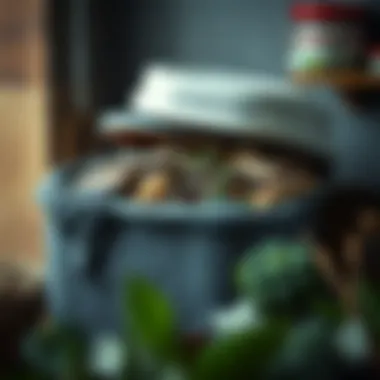
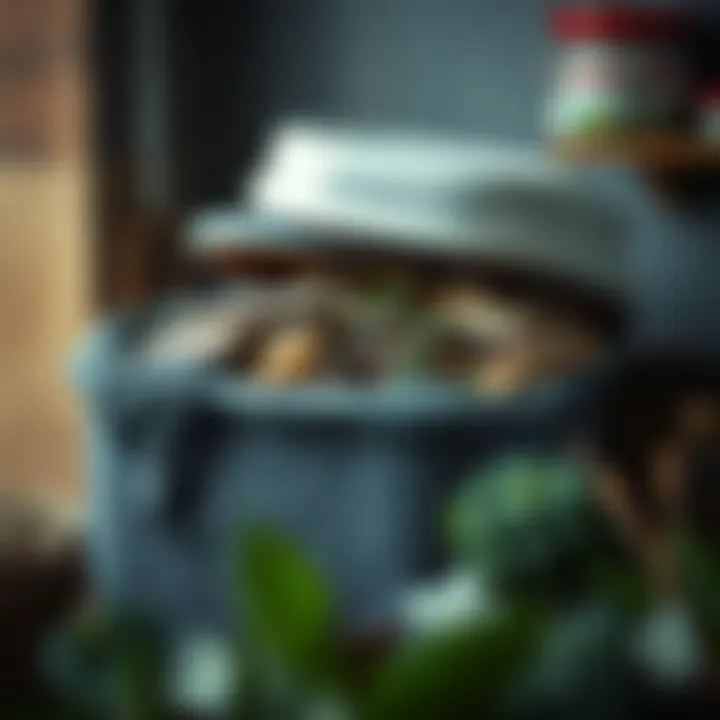
"Not all that glitters is gold; some compost ingredients do more harm than good."
A well-thought-out compost selection allows for a smooth decomposition process and results in a nutritious soil amendment. Moreover, practicing mindful composting is not just about recycling waste but also about fostering environmental sustainability. It enhances soil health, supports gardening efforts, and reduces landfill waste. Remember, your compost is only as good as what you put into it.
Setting Up Your Kitchen Compost
Setting up your kitchen compost is a crucial step in transforming kitchen scraps into nutrient-rich soil. This process not only reduces waste but also provides an excellent amendment for gardens and potted plants, encouraging a sustainable lifestyle. In this section, we'll delve into the importance of choosing the right compost bin and the considerations that should guide its placement within your home.
Choosing a Compost Bin
The compost bin you select can make all the difference in how effectively your composting endeavor flourishes. There’s quite a variety of bins available—from simple DIY options to more sophisticated models. Here’s what to consider:
- Size: The size of the bin should accommodate your composting needs. For a small household, a three-foot-by-three-foot bin may suffice, but larger families may need something more substantial to keep up with the volume of organic waste.
- Material: Compost bins come in many materials, from plastic to wood. Wooden bins often blend nicely with garden aesthetics, appreciating a natural touch. However, plastic bins tend to hold heat better, speeding up the composting process.
- Type of Bin: Do you want a stationary bin, or would you prefer a tumbler that allows for easier mixing? Tumblers can be a bit pricier, but they provide excellent aeration and simplify turning the compost, which can be a chore in stationary bins.
- Ventilation: Ensure your bin has adequate airflow. This helps material decompose efficiently by letting in oxygen. If you opt for a covered bin, be mindful of air holes.
Choosing the right compost bin doesn’t have to break the bank. Many great options can be crafted from old pallets or even plastic containers you might already have lying around. It's about making it work best for you.
Placement Considerations
Once you’ve decided on the bin, placement is the next hurdle to tackle. An excellent spot can streamline the process and minimize frustrations. Here are a few considerations:
- Accessibility: Place the bin where it’s easy to access from your kitchen. The closer it is, the more likely you will regularly add scraps. A location near the back door might be perfect, allowing easy access while minimizing the chance of mess inside.
- Sunlight: Most compost piles benefit from a warm spot that gets partial sun. Too much shade can slow decomposition, and in contrast, excessive direct sunlight can dry out your compost. Finding a balance is key.
- Drainage: Ensure the ground underneath allows for proper drainage. Compost likes moisture but doesn’t do well in soggy conditions. You want to create an environment where the moisture can escape, yet it remains adequately wet for decomposition.
- Proximity to Plants: Keep the bin close to areas where you plan to use your compost. This can make applying your compost much easier and encourage you to use it more frequently.
"The right compost bin and its position can turn your kitchen scraps into garden gold with ease."
Thinking through these factors is essential. A little bit of planning can lead to a smoother composting experience and a flourishing garden. Keep it simple, yet purposeful, and soon enough, your kitchen waste will become a treasured resource.
The Composting Process
The process of composting is the heart and soul of transforming kitchen scraps into nutrient-rich soil. Engaging in composting isn't just a method of recycling food waste; it’s a holistic approach that nourishes the environment and cultivates healthy plants.
By understanding the intricacies of the composting process, one can unlock the potential of their kitchen waste. Here, we delve into the essential elements that make up an effective compost system, how to optimize it, and the numerous benefits that stem from mastering these techniques.
Layering Techniques
Layering is a fundamental practice in composting that ensures a balanced mixture of green and brown materials. It's like creating a layered cake, where each component serves a purpose. Green materials—such as vegetable scraps, coffee grounds, and grass clippings—provide nitrogen, while brown materials—including dried leaves, cardboard, and straw—supply carbon.
The ideal ratio is roughly
- Two parts brown materials to one part green materials.
It's crucial to alternate layers; start with a thick layer of browns to help absorb moisture and avoid smells before adding greens. This layering technique not only promotes decomposition but also maintains aeration within the compost pile.
When layering, consider the following points:
- Chop up larger scraps to encourage faster breakdown.
- Mixing in each layer helps to better integrate materials, speeding up decomposition.
- Keep layers about six inches high—too thick might restrict airflow.
By laying this groundwork—quite literally—you will set the stage for efficient compost breakdown.
Moisture Management
Just as plants need water, composting materials require the right amount of moisture to thrive. Striking a balance is crucial; too much moisture can lead to anaerobic conditions, fostering unpleasant odors, while too little moisture can slow decomposition to a crawl.
Ideal moisture levels should feel like a damp sponge—not dripping wet. Here’s how to manage moisture effectively:
- Monitor your pile or bin regularly. If it’s too dry, add some water or moist materials like fruit scraps.
- If it’s too wet, mix in dry materials. Adding shredded newspaper or dried leaves can help absorb excess moisture.
- Cover the compost bin if it's raining to prevent saturation.
Maintaining proper moisture levels encourages the microorganisms to do their work efficiently, contributing to the creation of high-quality compost.
Aeration Methods
Aeration is another key player in the composting process. Just like a campfire needs air to keep burning, compost needs airflow to decompose effectively. Aerobic microbes work best when oxygen levels are high, and allowing air to circulate within the compost pile accelerates the composting process.
To ensure adequate aeration, consider these methods:
- Turning the pile regularly, about every two weeks, helps introduce oxygen and redistributes materials for more uniform decomposition.
- Using a pitchfork or compost aerator tool makes it easier to break up compacted layers and mix in air.
- Creating a well-structured pile with the right ratios and a good blend of materials can promote airflow naturally.
By applying these aeration techniques into your composting habits, the whole process speeds up, resulting in rich black gold more quickly than you can imagine.
“Good composting is like alchemy; you turn scraps into something wonderful.”
Understanding and leveraging these composting processes will empower you to create an environment where waste turns into wealth—a cycle that benefits not just your garden but also the planet.
Monitoring Your Compost
Keeping an eye on your compost is vital. It's not just about tossing scraps into a bin and calling it a day. Monitoring helps ensure that your compost breaks down effectively and is ready for use when you need it most. It’s like a fine wine; it requires attention and adjustment to reach its full potential. Here, we’ll look closely at two key elements of monitoring that every aspiring composter should know: temperature changes and recognizing odors.
Identifying Temperature Changes
Temperature is a telltale sign of the composting process. When you start a new pile or batch, it’s normal to see the temperature rise. This occurs as microorganisms break down the materials, generating heat in the process. Ideally, the temperature should range between 130°F to 160°F. This range ensures that the compost is active and that harmful pathogens and weed seeds are being destroyed in the process.
To check the temperature, you can use a simple compost thermometer. Just insert it into the center of the pile and read the dial. Regularly monitoring the temperature can provide insights into how your compost is faring and when it might need some adjustments.
- Too Hot? If your compost exceeds 160°F, it can become anaerobic, leading to a decrease in microbial activity. To cool it down, turn the pile to introduce more oxygen.
- Too Cold? On the flip side, if temperatures drop below 130°F, you might want to add more green materials or stir the pile to help reinvigorate activity.
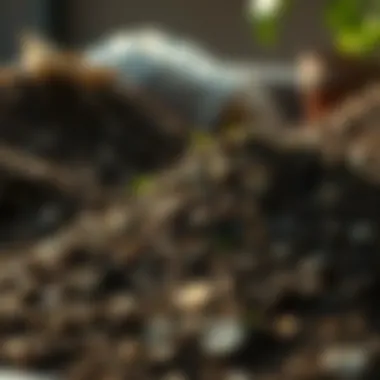
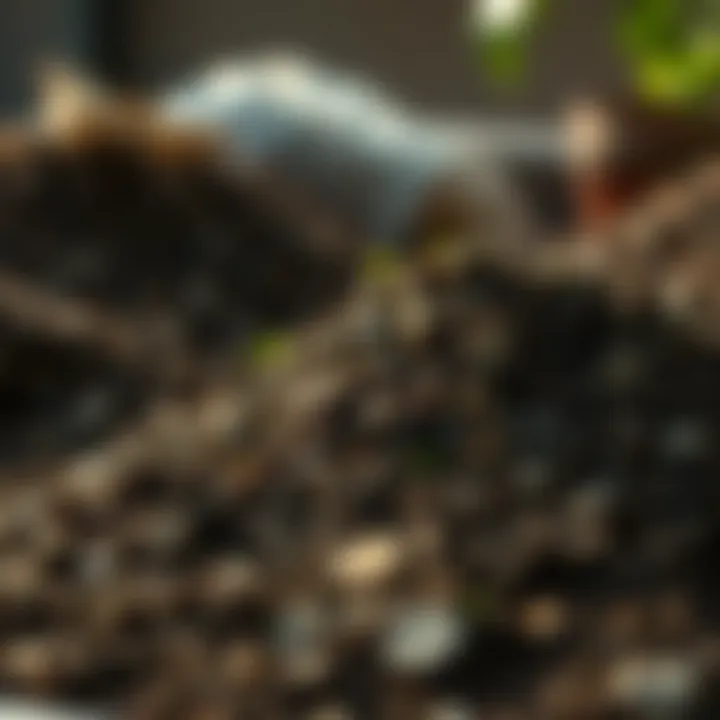
By keeping tabs on temperature fluctuations, you’re essentially tuning your compost to an ideal state, much like adjusting the gears of a bicycle for a smoother ride.
Recognizing Odors
Odor is another key element in monitoring your compost. Different smells can signal various issues, so being attuned to the scents wafting from your bin can save you a lot of headache. A well-maintained compost pile should have an earthy smell.
Suppose you encounter foul or rotten odors, that’s a red flag. Generally, this means there’s an imbalance in the compost.
"A great compost smells like a walk in the woods, not a dumpster behind the local diner.”
Here’s how you can decipher your compost odors:
- Foul Smell: This indicates that your pile is too wet or that it has too much nitrogen-rich material. In this case, add more brown materials to balance things out and turn the pile to aerate it.
- Ammonia Smell: If you detect a strong ammonia scent, your compost may be too rich in greens. Again, adding browns might be the solution.
- Earthy Aroma: If everything is right, you'll be greeted by a pleasant smell that suggests the decomposition process is on track.
By honing in on the aromas and making adjustments, you can guide your composting journey toward success. Monitoring and responding to these indicators will ultimately lead to a rich, nutrient-packed compost ready to nourish your soil and plants.
Troubleshooting Common Issues
When diving into the world of kitchen composting, you'll find a range of benefits. However, it’s not all sunshine and rainbows in the compost bin. Troubleshooting common issues is paramount to ensure your compost stays on track and yields the rich, nutrient-dense soil you're aiming for. Addressing these problems early can make all the difference. No one wants to discover a stinky mess or a soggy mound where they expected lush compost. Thus, understanding potential pitfalls and how to avoid them is crucial for novice and seasoned composters alike.
Excess Moisture Solutions
Moisture in composting is a bit like Goldilocks—there's a happy medium that must be reached. Too little moisture can stifle the breakdown process while too much can lead to anaerobic conditions. If your compost is beginning to resemble a swamp, it’s time to take action. Here are some practical solutions:
- Layer It Up: Incorporate more brown materials like dry leaves, straw, or paper into your pile. These will soak up excess moisture and provide the carbon needed to balance out the dampness.
- Aerate Regularly: Give your compost a good turn. Introduce air by mixing the materials. This will help in evaporating some of that excess moisture and keep the microorganisms thriving.
- Cover It Up: If your compost bin isn’t well-ventilated, or if it’s being hit by heavy rain, consider using a lid or tarp. This can shield it from excess water while allowing air circulation.
- Check the Base: Ensure your compost bin has adequate drainage. Sometimes the bottom can get clogged, leading to pooling.
Taking these steps should help to get that compost back on the right track. Remember, a balanced compost heap isn't just preferable; it’s essential.
Odor Elimination Techniques
A compost that smells like something died can be off-putting and a clear signal that something is amiss. If you’re catching whiffs of something less than pleasant, it's vital to nip the issue in the bud before it turns into a full-blown crisis. Here are some tips for eliminating unwanted odors:
- Correct the Carbon-to-Nitrogen Ratio: A common culprit behind unpleasant smells is too much nitrogen and too little carbon. Aim for a ratio of about 30:1, where carbon materials (brown) outnumber nitrogen materials (green).
- Aerate the Pile: Just like with moisture, odors often arise from anaerobic conditions—those without oxygen. Regular turning of the pile introduces much-needed air and helps disperse any funky smells.
- Add Bokashi: If the scent is particularly stubborn, integrating Bokashi can work wonders. This fermented organic matter introduces beneficial bacteria that help neutralize odors.
- Chop It Up: Breaking larger pieces down into smaller bits increases surface area and speeds up decomposition, ultimately reducing odor issues.
By understanding common issues like excess moisture and unpleasant odors, kitchen composters can refine their approach and transform potential setbacks into manageable situations. After all, the goal of composting extends beyond just disposal; it’s about nurturing a cycle that transforms waste into a wonderful resource.
Using Your Compost
Using compost effectively can immensely change not only your garden's output but also how you perceive waste in your daily life. Compost transforms kitchen scraps and yard waste into a treasure chest of nutrients that plants crave. It's almost like having a small miracle in your own backyard or balcony. However, how you use that compost matters just as much as the compost itself.
Application in Gardening
When it comes to applying compost in your garden, timing and technique are key factors to ensure your plants get the maximum benefit. You can sprinkle the compost across your planting beds or mix it into the soil before planting. Think of it this way: providing compost is like serving a full course meal to your hungry plants. They won’t just appreciate it; they'll thrive on it.
Here are some effective ways you can apply compost in your garden:
- Top Dressing: Spread a layer of compost over the soil surface. It improves moisture retention and encourages beneficial organisms.
- Soil Amendment: Mix the compost into the garden soil before planting. This helps to improve soil structure and nutrient content.
- Compost Tea: Steep compost in water for a few days, then strain and use the liquid as a nutrient booster for your plants. This is an excellent way to deliver nutrients directly to the roots.
By incorporating compost, you not only provide nutrients but also improve soil life, enhancing the overall health of your garden. Moreover, using your compost also means your plants are getting organic material, which can deter pests and diseases.
"Composting is not just about recycling waste; it's about enriching your garden and taking a step towards sustainability."
Enriching Potted Plants
Potted plants often present unique challenges, especially concerning soil health. But adding compost to the mix can significantly enhance your plants' growth prospects. The difference can be night and day when it comes to maintaining moisture and supply of nutrients in container gardenings.
To enrich potted plants, you can:
- Mix into Potting Soil: When repotting, blend compost with store-bought potting soil to create a nutrient-rich base. This ensures the plants have the essential nutrients available right from the start.
- Use as a Top Layer: A layer of compost on top can slow moisture evaporation, reducing the need for frequent watering and keeping your plants happy.
- Feed Regularly: During the growing season, mix a small amount of compost into the pots every month or so. This helps replenish nutrients that may have been used up, keeping your plants in tip-top shape.
Utilizing compost in potted plants is not just an easy way to promote growth; it's a sustainable practice that contributes to a healthier planet, reducing waste while fostering blooming beauty in your space. Giving those little green friends nutrient-rich conditions can lead to a vibrant display of life.
Using compost wisely has far-reaching benefits, beyond merely fertilizing your plants. It fosters an entire ecosystem within pots and plots, giving you something to be proud of while boosting your gardening game.
Composting in Urban Settings
Composting in urban areas presents unique challenges and opportunities. As cities expand, more people live in apartments or homes with limited outdoor space. This situation makes traditional composting methods less feasible. However, the advantages of composting are too significant to ignore, and innovative solutions have emerged to make it possible even in the tightest of quarters.
Urban composting not only helps reduce waste going to landfills but also enhances local environmental quality. The soil in city gardens often lacks nutrients. Utilizing compost can improve soil structure and fertility, contributing to better plant growth. Additionally, it fosters community engagement among city dwellers focused on sustainability. No doubt, this becomes an effort that transcends individual lifestyles and promotes collective action.
Adapting to Space Constraints
When living in a cramped apartment or small house, one may feel it’s impossible to start composting. But that’s simply not the case. Here are some clever ways to adapt composting methods to small spaces:
- Compost Bins: Invest in compact compost bins designed for indoor use. Many are odor-free and make it easy to manage food scraps.
- Worm Bins: Vermicomposting is a viable option. You can use worms in a small container to break down organic waste.
- Bokashi Composting: This method ferments food scraps. It requires little space and can even be done inside.
To make the best out of a small area, consider placing your compost system in a closet, under the sink, or on a balcony. With these adaptations, composting can seamlessly fit into your urban lifestyle, providing you with quality compost without the need for large outdoor spaces.
Community Composting Initiatives
In many urban areas, community composting initiatives have sprung up as a response to the challenges of individual composting. These programs aim to unite people in their efforts to reimagine waste. They allow residents to drop off food scraps at designated locations rather than struggling to compost at home.
Benefits of Community Composting:
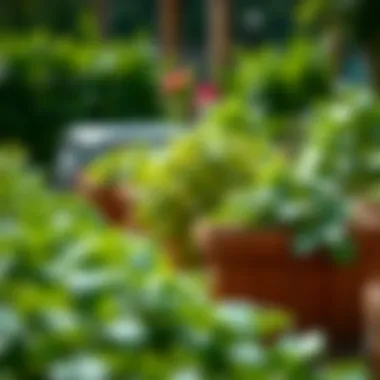

- Education and Awareness: Community initiatives often include workshops to educate participants about composting practices.
- Shared Resources: By pooling resources, communities can invest in larger composting systems that yield compost in bulk.
- Building Relationships: These programs nurture a sense of community, allowing neighbors to connect while promoting environmental consciousness.
Many municipalities have embraced community composting. Cities such as San Francisco and New York have sizable programs that encourage residents to participate in sustainable practices. If you're looking to become part of such an initiative, check local community boards or municipal websites like cityofsanfrancisco.gov for more information.
"Community composting transforms mere waste into shared enthusiasm for sustainability, fostering connections that go beyond the compost bin."
In wrapping up, while urban living may present unique composting challenges, it certainly doesn’t eliminate the possibility. With innovative approaches and community support, composting in cities can flourish. Engage with your community to learn more and possibly inspire others to take part!
Advanced Composting Techniques
When it comes to composting, the basic method of piling kitchen scraps and yard waste is a good start, but there's a whole world of advanced techniques that can enhance and expedite the composting process. Understanding advanced composting methods not only enriches the soil but also offers efficiency, especially for those who may feel constrained by time or space. It’s also a wonderful way to dive deeper into the world of waste recycling, turning scraps into something incredibly beneficial for your garden.
Vermicomposting
Vermicomposting, or worm composting, uses certain types of worms to break down organic material into nutrient-rich compost. This technique has grown in popularity due to its effectiveness and the rich, beneficial compost it produces. The main stars here are the red wigglers, which thrive in an environment rich in organic matter. These worms convert waste into compost faster than traditional methods, and they do wonders for the soil.
Key Benefits
- Speedy Process: Worms can produce compost in as little as a few weeks, much quicker than traditional composting methods.
- Balanced Fertilizer: The compost created is rich in nitrogen, phosphorus, and potassium, essential nutrients for plants.
- Space Efficient: Ideal for urban dwellers with limited space, as a worm bin can fit neatly in a kitchen or basement corner.
Considerations
While vermicomposting is generally easy, it does require some care. Temperature control is important—too hot or too cold can harm the worms. A good balance of green and brown materials is necessary as well. For anyone wanting to get real, fertile soil fast, vermicomposting could be the way to go. It’s not just a chore; it’s a fascinating interaction with nature.
Bokashi Method
The Bokashi method is different from traditional composting because it uses anaerobic fermentation rather than decomposition. By adding kitchen waste to a specially designed Bokashi bucket, you enable the waste to ferment with the help of a mixture of microbes that can handle even meat and dairy.
Key Benefits
- Versatile: Accepts a wider variety of waste, including things like cooked food scraps, oils, and even dairy products, which traditional composting usually doesn't.
- Odor Control: The fermentation process is fairly odorless, making it suitable for indoor settings.
- Prepares for Soil: The Bokashi compost can quickly be buried in soil after fermentation, improving soil quality and promoting healthy plant growth.
Considerations
Bokashi doesn’t produce finished compost immediately; instead, it creates a pre-compost state. After the fermentation, it needs to be buried underground to complete the composting process. Given this method’s unique requirements, it’s crucial to follow the steps closely and monitor the balance of materials used in the fermentation.
In essence, advanced composting techniques like Vermicomposting and the Bokashi method provide effective options for transforming kitchen waste into rich compost. They can cater to various lifestyles and preferences, empowering more individuals to take part in eco-friendly practices.
For more detailed guides on composting and techniques, you can check resources like Wikipedia on Composting and various community boards on Reddit. These platforms can provide valuable insights and experiences from fellow compost enthusiasts.
Building Community Around Composting
Building a community around composting fosters a sense of belonging and shared purpose among individuals who share a common goal: reducing waste and enhancing sustainability. It’s not just about turning kitchen scraps into nourishing soil; it’s about cultivating connections with others who are invested in the same practices and passions. A vibrant composting community can invigorate the movement towards environmental awareness and responsible waste management.
Here are some key benefits of community involvement in composting:
- Shared Knowledge: When we gather, so do our experiences. Individuals can exchange tips and tricks gained through their own composting journeys. For instance, someone might have faced an issue with fruit flies and discovered an effective repellent that can help the others facing the same dilemma.
- Collective Action: A united front can have a more substantial impact. Whether it’s advocating for local composting programs or participating in clean-up campaigns, working together amplifies the message.
- Resource Availability: A community can pool resources, whether it be tools, compost bins, or even knowledge on where to find quality brown materials. When one person has excess leaves or straw, sharing these with fellow composters can provide a win-win situation.
Educational Workshops
Organizing educational workshops can be a powerful way to spread awareness about composting. These workshops could cover a wide range of topics, from the basics of composting to advanced techniques like vermicomposting. They provide an opportunity for participants to get their hands dirty and learn in a practical setting.
Such workshops not only boost enthusiasm but also allow individuals to ask questions that are often overlooked in written guides. As people share their stories and hurdles, the workshops become a treasure trove of insights and practical wisdom. For instance, attendees can learn how to balance greens and browns effectively or troubleshoot compost that reeks of ammonia.
By educating others, participants create a ripple effect that extends beyond their immediate community, encouraging more households to take up composting.
Sharing Resources and Knowledge
In an effective composting community, knowledge and resources are shared freely. Websites such as reddit.com have forums dedicated to composting where individuals can ask questions and learn from one another's experiences. This flow of information is crucial for cultivating a successful composting practice.
Besides online platforms, local libraries can become great repositories for books on sustainable practices. Furthermore, community members can organize swap days where they exchange not only compost materials but also seedlings, gardening tools, and excess produce. This exchange of resources enhances community relations and helps promote a circular economy—the more we share, the less we waste.
Finally, connecting with local environmental agencies or organizations can strengthen this effort. They may offer grants or resources that can support community initiatives. In combining these efforts, communities can lay down solid roots for a sustainable future, nurturing environments that promote composting and recycling like a well-tended garden.
By building a community around composting, we not only enrich our local landscapes but also empower each member to take action, one kitchen scrap at a time.
The Future of Kitchen Composting
As we look ahead, the future of kitchen composting emerges as a pivotal component for sustainable living. With the growing awareness of environmental issues and the necessity for efficient waste management, more households are seeing composting not just as a gardening aid, but as part of an essential lifestyle. Whether it’s the desire for a greener planet or the quest for nutritious home-grown food, this practice is becoming more mainstream. Kitchen composting is set to reshape our relationship with waste and sustainability, offering both immediate benefits as well as long-term solutions to the pressing challenges of our time.
Innovations in Composting Technology
Composting technology is advancing rapidly, bridging the gap between traditional methods and modern conveniences. Innovations in this field hold great promise for enhancing composting efficiency and user experience. Take for example, smart composting bins that utilize sensors to monitor temperature, moisture, and the presence of pests. Such devices can send real-time updates to your smartphone, keeping you informed on the health of your compost.
Another development is the emergence of accelerated composting systems. They can break down organic waste at an accelerated pace, sometimes within days, instead of months, transforming scraps into compost almost overnight. The introduction of enzyme-based compost starters is also noteworthy; these break down organic matter more effectively, thus expediting the composting process.
"Innovative composting solutions are not just about convenience; they represent a significant step toward more sustainable living."
These advancements highlight a broader trend towards reducing waste, encouraging individuals and families to engage actively.
By simplifying the composting process, technology could inspire even the most hesitant participants to give it a try.
Integrating Composting into Daily Life
To truly embrace kitchen composting, it must become a natural part of daily routines rather than an added chore. This integration requires a mindset shift, viewing composting as an extension of food preparation and waste disposal rather than a separate task. One effective approach is setting up a compost station beside your regular garbage can in the kitchen.
By designating a specific spot for compostable materials, you reduce the likelihood of accidentally tossing these items in the trash. Regular reminders can also help; for instance, carrying out scraps every few days can become part of a weekly ritual.
Involving the entire family in the composting process can promote a shared sense of responsibility. Children, in particular, can learn about environmental stewardship first-hand. You might consider organizing family food prep sessions where each member can help separate compostable waste.
Additionally, integrating composting into community activities can enhance its visibility and importance. For example, sharing success stories in neighborhood gatherings or social media groups raises awareness and encourages communal composting efforts.
In summary, as we look ahead, the integration of composting into our daily routines, coupled with ongoing technological advancements, will only serve to enrich the sustainability narrative. It encourages a generation that not only understands the importance of responsible waste management but actively participates in it, ensuring the health of our planet for those who come after us.















